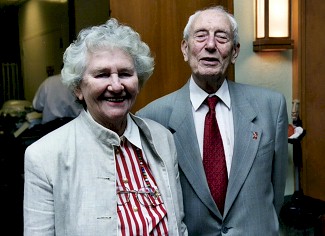| |
In Appreciation Of Mervyn Susser (1921-2014)
By Nigel Paneth
[Ed. Nigel Paneth of
Michigan State University studied with Mervyn Susser at Columbia and
conducted an interview of him published in the Voices feature of
Epidemiology in 2003. We invited Dr Paneth to provide this up close
remembrance of Mervyn Susser.]
I am one of many who
had the privilege of having been taught and mentored by Mervyn
Susser, and I am surely not alone in deeply feeling and mourning his
loss, though he lived as long and productive and exciting a life as
anyone could wish for.
Early Career
Mervyn belonged to
that great generation of epidemiologists who helped to shape the
scope and form of chronic disease epidemiology in the 1950’s. Born
in South Africa and exiled by apartheid, his first academic post -
in Manchester - brought him into the orbit of the British wing of
those epidemiologic pioneers. But he differed from Jerry Morris
and Richard Doll and many of his epidemiologic contemporaries
in his deep immersion in the social sciences, and his emphasis on
the philosophical and methodological roots of epidemiology. His
first book, co-authored with the sociologist William Watson,
was titled Sociology in Medicine (1962) and covered a far
larger territory than just epidemiology. A necessary narrowing of
his focus to epidemiology came with his appointment, in 1966, as
Chair of Epidemiology at the School of Public Health at Columbia
University, which already had a division of Sociomedical Sciences.
Mervyn once recounted to me how he divided the academic turf with
that division’s head, Jack Elinson. Studies whose outcome
was a human behavior belonged in Sociomedical Sciences; studies
whose outcome was a health disorder belonged in Epidemiology.
Two-Themes
At Columbia, Mervyn
developed the two themes for which he is best known – his lifelong
engagement with the philosophy of epidemiology, and the
establishment of the Dutch Famine Cohort Study with Zena Stein, his
wife and colleague. An aside is necessary here. It is difficult to
write an appreciation of Mervyn Susser by himself. His work and
Zena’s were so wonderfully intertwined that I sometimes think I was
taught by a single epidemiologist named MervynandZena. It is
generally assumed that one arena that Mervyn took as his own
province was the exploration of the conceptual bases of
epidemiologic thought and practice. Yet even here one must note his
dedication to Causal Thinking in the Health Sciences (1973) -
“This book is for Zena, with her, and of her”.
Health
Consequences
Mervyn was an
epidemiologist fully engaged with the social and political
implications of epidemiology. This was most strongly manifest in
his lifelong struggle against apartheid, which began in the 1940’s
alongside Mandela, Sisulu, Tambo and other ANC leaders. His
anti-apartheid activities led to his being forced to resign from his
clinical post in Alexandra township and his departure for England.
Their home in Hastings, NY was ever full of political exiles
visiting or finding refuge. Zena would sometimes remind us that
Mervyn was just continuing his father’s profession; Solomon Susser
had been an innkeeper in the remote Transvaal.
Dutch Famine
Study
Mervyn knew how to separate the political from the scientific. The
Dutch Famine study revealed that, contrary to popular wisdom at the
time, a famine so desperately severe that many women delivered
weighing less than they had at conception, and where birthweight at
the famine peak dropped by 250 grams, produced no deleterious effect
on adult IQ (at least in men, where data were available). I once
witnessed a presentation of these data where a progressive physician
argued that the data should be censored because they could be used
to obstruct prenatal nutrition programs. But
Famine and
Human Development: The
Dutch Hunger Winter of 1944-1945 (1975)
and
numerous papers argued firmly for the validity of these negative
findings. Criticism also flew in when Mervyn, Zena and their
colleague David Rush published the findings of the Harlem Prenatal
Nutrition trial which showed that nutritional supplementation in
pregnancy had very modest effects on fetal growth, and adding
protein to the diet might actually harm fetal growth. These
experiences showed that overturning received knowledge is not always
taken kindly in academe, and I learned from Mervyn and Zena that
good scientists carefully separate science from advocacy.
Mentor
Mervyn was an extraordinary mentor. As a lecturer, he lacked the
flair for drama that makes for good student ratings, but in a small
group he exuded wisdom. He could find a scientific context and
precedent for any topic under discussion, and he had an uncanny
ability to get to the heart of an issue, discarding the
irrelevant. In practical matters, such as the construction of a
field team or the development of a research budget, he saved many of
his younger colleagues from serious errors. He looked for the best
in people, especially younger scientists whose abilities were not
yet fully developed or even apparent. He was encouraging without
being uncritical, as anyone who went through dozens of drafts of a
paper with him will remember.
Giant In The Field
Born
in a remote African village, his education interrupted by six years
of WW II military service, and with hardly any formal education in
epidemiology, he nonetheless became a giant in our field. And he
nourished many epidemiologists, including his son Ezra and his
nephew Aryeh Stein, making epidemiology into a family business. But
in the warmth of the MervynandZena world we were all family.
■
|

Mervyn & Zena Susser
|
|
|